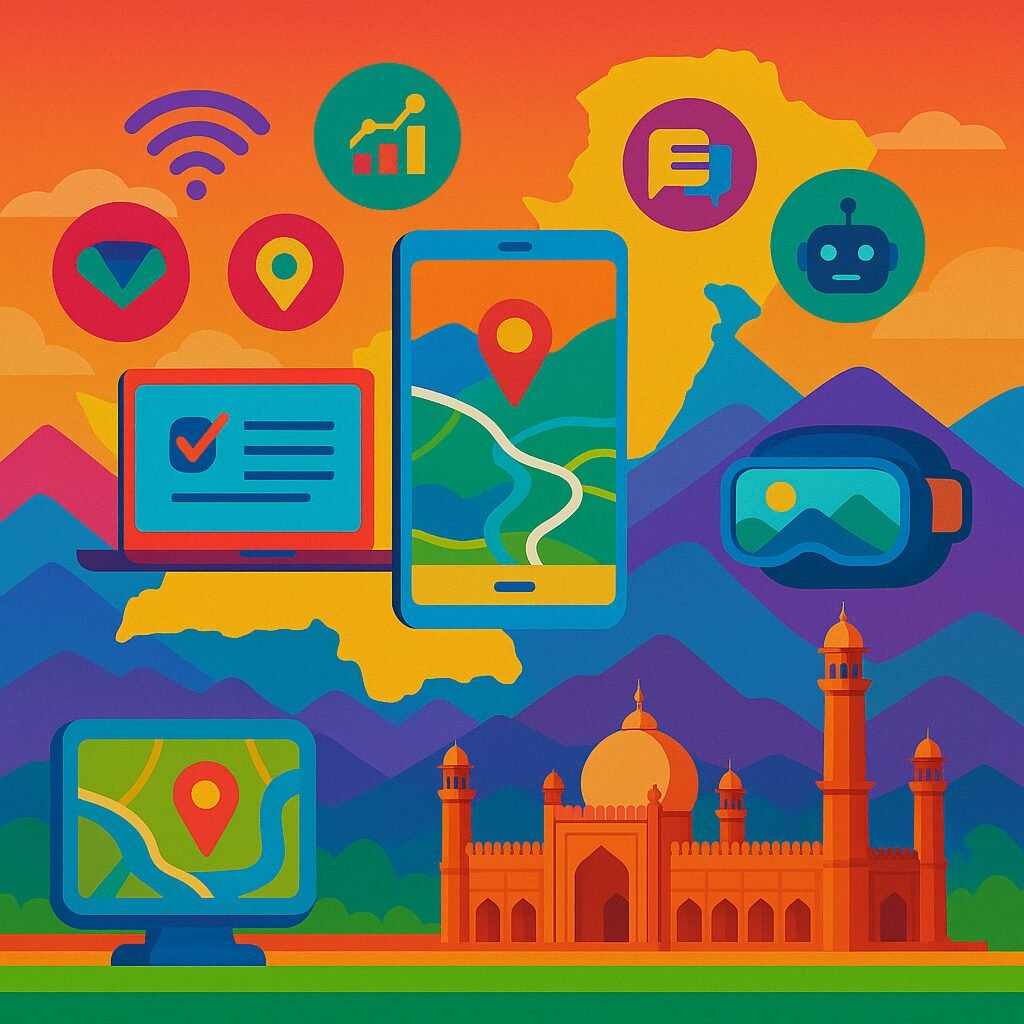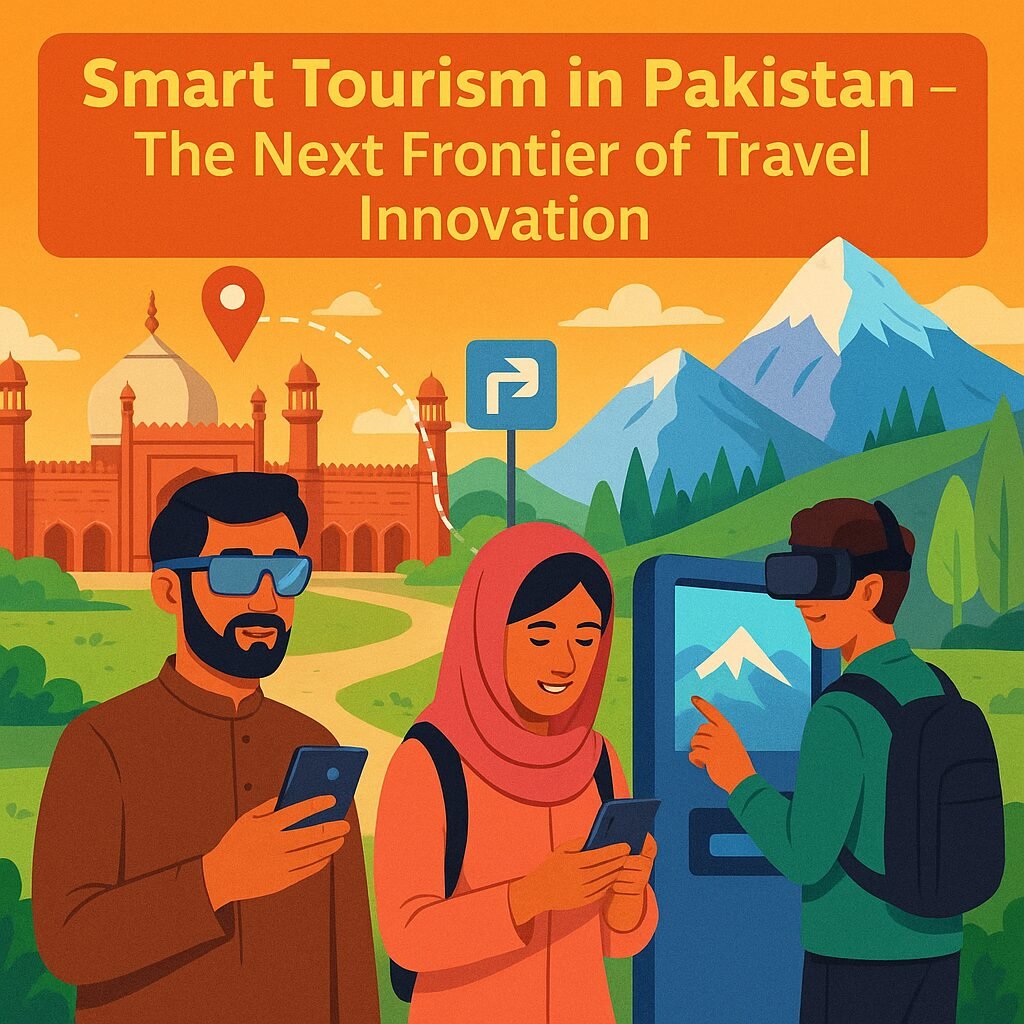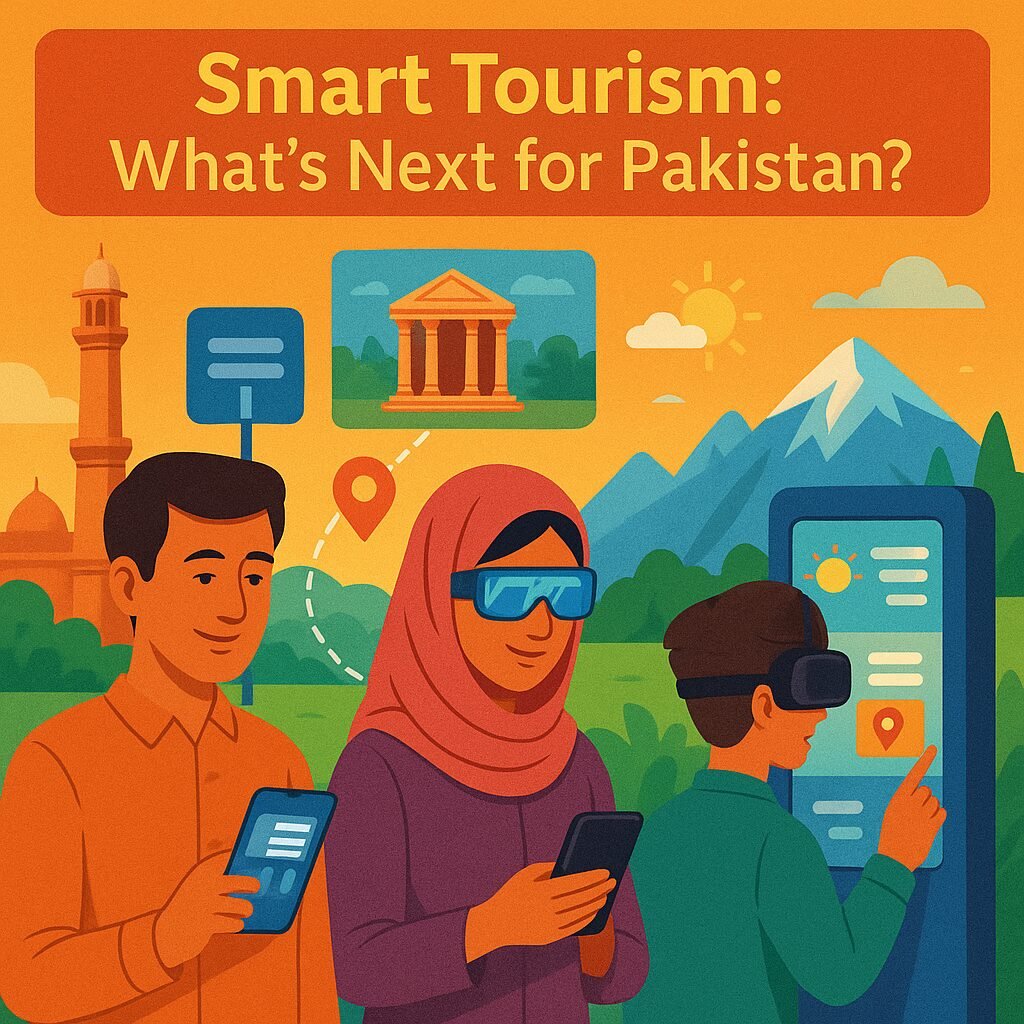A Nation on the Digital Move


“From Swat to Gwadar, Pakistan’s breathtaking beauty is no longer a secret—but how we experience it is evolving.”
Tourism has always been a powerful way to connect people with nature, history, and culture—but today, the journey begins long before the first step is taken. Across the world, travelers are trading guidebooks for Google, paper maps for real-time navigation, and word-of-mouth for AI-powered recommendations. And Pakistan—home to some of the world’s most unexplored landscapes and rich heritage—is rapidly catching up.
With nearly 190 million mobile connections and over 116 million active internet users, Pakistan is no longer just a destination for physical exploration—it’s becoming a destination for digital discovery. This connectivity boom has empowered travelers and tourism stakeholders alike, making it possible to plan entire journeys from a mobile screen, compare options in real time, and share experiences with the world instantly.
This transformation isn’t just about convenience—it’s a catalyst for access, inclusion, and innovation. In remote areas where information was once hard to find, digital tools now serve as bridges between curious explorers and local communities. Booking a zipline in Swat, navigating heritage walks in Lahore, or finding eco-lodges in Gilgit-Baltistan has become easier through mobile-first platforms. Interactive maps, live navigation, AI assistants, and immersive AR/VR experiences are reshaping how Pakistan is seen, explored, and remembered.
In this blog, we explore how Smart Tourism in Pakistan is redefining travel across three pivotal stages:
-
Planning – The rise of intelligent assistants, personalized itinerary generators, and seamless digital guides tailored to interests, season, and budget.
-
Discovery – The influence of digital storytelling through social media, 360-degree virtual tours, and content-driven destination branding.
-
Execution – Streamlined bookings, mobile payments, travel safety apps, real-time crowd data, and IoT-driven experiences on the ground.
This evolution is not abstract. It’s happening now—through public-private partnerships, provincial innovation, and the work of platforms like TrulyPakistan, which are building a future where technology enhances—not replaces—authentic travel.
The story of tourism in Pakistan is no longer just written on paper—it’s being built in code, shared on screens, and powered by people. Let’s explore what this future looks like, together.
Smart Tourism in Pakistan – The Next Frontier of Travel Innovation


Smart Tourism in Pakistan – The Bold Frontier of Travel Innovation
What Is Smart Tourism?
Smart tourism represents a powerful convergence of digital technology and travel—a framework where artificial intelligence (AI), the Internet of Things (IoT), augmented and virtual reality (AR/VR), and data analytics are woven into the travel experience. This integration doesn’t just make journeys more convenient—it makes them smarter, more personalized, and far more sustainable.
At its core, smart tourism transforms how destinations are explored, promoted, and managed. Travelers no longer just consume experiences—they interact with them, shape them, and amplify them in real time. It’s a shift away from one-size-fits-all tourism toward hyper-personalized journeys where preferences, context, and data shape every recommendation. This idea mirrors the global movement toward smart cities, where connected systems enhance urban living through intelligent design, data insights, and digital interfaces. In tourism, this translates into smoother trip planning, real-time alerts, intuitive navigation, and digitally enriched storytelling.
How Pakistan Is Embracing Smart Tourism
Pakistan has begun embracing this shift, especially in provinces like Khyber Pakhtunkhwa (KP) and Punjab, where focused innovation and bold policy steps are reimagining how travel works. In KP’s northern valleys, digital tools have replaced guesswork with clarity. Tourists can now use mobile applications to book camping pods in Kumrat, check real-time weather conditions in Chitral, or find curated trails in Swat—all from their phones. These tools make remote destinations more accessible, helping visitors plan with confidence and safety.
Punjab, on the other hand, is leaning into smart heritage tourism. In cities like Lahore, QR-coded plaques have been installed at major historical sites, allowing tourists to access multilingual guides simply by scanning with their phones. These immersive, touchless experiences not only enrich the visitor’s journey but also eliminate the need for printed material or physical tour guides—making the process both sustainable and scalable.
Transport infrastructure is evolving too. With connected systems providing live traffic updates, optimized routes, and e-ticketing for public buses, tourists can now navigate cities more fluidly. These advancements are backed by collaborations between government departments, private tech firms, and academic research groups, each contributing to the foundation of a smarter, more agile tourism ecosystem.
Future Technologies Driving Smart Tourism in Pakistan
Looking ahead, Pakistan’s tourism landscape is ripe for deeper transformation. The integration of AI-powered itinerary planners is on the horizon—tools that will analyze not just destination popularity, but also traveler mood, time of year, weather conditions, and budget constraints to generate highly customized travel plans.
Meanwhile, augmented and virtual reality are poised to bring heritage sites to life in entirely new ways. Imagine walking through the ruins of Mohenjo-Daro and seeing a digital reconstruction of the ancient civilization layered over the ruins through your phone or smart glasses. These tools make cultural exploration more interactive, more emotional, and accessible even to those unable to visit in person.
Further innovation lies in the rollout of smart kiosks and multilingual e-guides, powered by IoT and backed by real-time analytics. These systems could provide live crowd data, safety alerts, or even eco-advice based on environmental conditions—all tailored to enhance the visitor’s decision-making on the ground.
Such technologies aren’t futuristic wishlists—they’re fast becoming the norm in tourism-forward countries. For Pakistan, adopting them is not a luxury, but a necessity to remain competitive, inclusive, and resilient in the global tourism economy.
“Smart tourism in Pakistan is not just a trend—it’s a pathway to sustainable, immersive, and accessible travel experiences.”
Research Speaks – What Tourists Are Actually Using
Mobile-Driven Decision Making
A 2024 study published in the Journal of Asian Development Studies provides key insights into how travelers in Pakistan are embracing mobile technology. Based on a survey of 398 respondents, the research found that 62.4% of tourists now rely on mobile devices for planning their trips. This shift reflects a broader trend toward digital-first travel behaviors, where convenience, real-time access, and personalization are becoming central to decision-making.
Among the most commonly used features are digital maps, which help tourists navigate unfamiliar terrain with confidence. Travelers are also actively using mobile platforms to discover accommodation options, explore nearby dining spots, and plan efficient routes between attractions. The data confirms that mobile-first planning has effectively replaced the traditional dependence on travel brochures, physical maps, and on-ground inquiry.
Real Case – Lahore’s Interactive Map Model
Lahore stands out as a notable example of how local governments and developers are responding to this digital transition. The city has introduced an interactive, app-based map system that allows tourists to seamlessly explore its historic urban fabric. This digital interface includes dynamic pins identifying key landmarks, restaurants, and cultural sites. Each location is supported by information cards offering context, images, and relevant details—allowing users to learn as they move.
What makes the Lahore model especially effective is its integration of navigational tools. Visitors can follow suggested walking routes, view nearby transit access points, and engage with multimedia content linked to each stop. In a city as layered as Lahore—where colonial architecture, Mughal history, and contemporary urban life intersect—such digital enhancements are not only useful but necessary for delivering richer, more immersive tourism experiences.
This case demonstrates that when designed with the user in mind, mobile travel tools can greatly improve how destinations are discovered, understood, and enjoyed.
KP: A Digital Tourism Success Case
Tech Meets Nature in the North
Khyber Pakhtunkhwa (KP) has emerged as one of the leading regions in Pakistan when it comes to embracing digital tourism. From Ayubia’s chairlift bookings becoming available through online platforms to zipline and camping pod reservations in Swat Valley now manageable via mobile apps, KP is blending adventure tourism with accessible tech solutions. These services not only improve convenience for travelers but also reduce the friction that often discourages domestic or international visits to less-developed destinations.
Equally notable is KP Tourism’s growing focus on digital storytelling. The provincial government has used targeted social media campaigns, drone-based promotional videos, and influencer collaborations to reposition KP as a prime destination for eco-tourism and cultural exploration. These digital narratives have played a crucial role in attracting both foreign investment and international tourism interest, particularly from South Asia and the Middle East.
Private-Public Partnerships
The success of KP’s digital transition also rests on its ability to foster meaningful collaboration between the public sector and private innovation partners. Several app development firms, tech startups, and marketing agencies have worked closely with the KP Tourism Department to co-develop platforms that highlight key destinations, manage bookings, and offer real-time updates to visitors.
These partnerships have not only accelerated the rollout of user-friendly tools but have also introduced design thinking and data analytics into the core of tourism management. For instance, by analyzing visitor behavior through app usage data, KP authorities are able to make informed decisions about infrastructure planning, crowd control, and promotional strategies—ensuring tourism growth is both sustainable and scalable.
Economic Impact of Going Digital
Digital adoption is doing more than reshaping travel experiences—it’s directly influencing Pakistan’s tourism economy. As highlighted by reports from the Associated Press of Pakistan (APP) and Travelstourism.com, the introduction of smart tourism initiatives has opened new pathways for economic growth, particularly in underserved or rural regions.
Tourism contributes significantly to Pakistan’s GDP, and the integration of digital platforms has multiplied this potential. Online booking systems, mobile payments, and digital marketing have lowered entry barriers for small businesses such as guesthouses, local tour operators, and handicraft vendors. These tools allow micro-entrepreneurs to access broader markets, improving income stability and encouraging local entrepreneurship.
Moreover, digital visibility has made it easier for foreign investors to assess opportunities in Pakistan’s tourism sector. Regions like KP, Gilgit-Baltistan, and Balochistan—once overlooked due to logistical challenges—are now on the radar of investors, thanks to real-time content, reviews, and analytics made possible through digital infrastructure.
Perhaps most promising is the role of digital tourism in promoting eco-conscious travel. By using technology to streamline access to natural reserves, monitor tourist flow, and promote sustainable practices, Pakistan is slowly aligning its tourism growth with climate-sensitive development goals.
Smart Tourism: What’s Next for Pakistan?


AR/VR Experiences
As digital tourism continues to mature, immersive technologies like augmented reality (AR) and virtual reality (VR) are becoming powerful tools in shaping how tourists explore Pakistan. Virtual museum tours and 3D reconstructions of ancient sites are no longer limited to big global destinations. Pakistan’s own heritage-rich locations—from the ruins of Mohenjo-daro to the Buddhist relics of Taxila—can be transformed into immersive storytelling experiences that engage both remote users and on-site visitors.
These experiences not only enhance accessibility for those unable to travel physically but also serve as valuable educational and promotional content. A traveler can preview a historical site in VR before deciding to visit, deepening their appreciation and encouraging cultural preservation.
AI Itinerary Generators
Artificial Intelligence (AI) is poised to revolutionize how trips are planned, especially in countries with diverse terrains and variable travel conditions like Pakistan. Future smart tourism tools may include AI-based itinerary planners that consider traveler preferences, real-time weather forecasts, seasonal crowd data, and even budget constraints to generate optimized, day-by-day plans.
Such tools would eliminate the guesswork from travel and significantly enhance the user experience, particularly for international visitors unfamiliar with local transportation, accommodation, or customs. As these AI systems learn from traveler behaviors and feedback, the recommendations will become even more personalized and efficient over time.
IoT Integration
The Internet of Things (IoT) is expected to bring a new layer of intelligence to Pakistan’s tourism infrastructure. Smart signage that offers multilingual assistance, live crowd maps to prevent congestion at popular destinations, and real-time alerts for road closures or weather disruptions can significantly improve travel safety and convenience.
In the future, Pakistan’s tourism operations can be enhanced through platforms like Domin8 CRM, integrated with IoT-based tourism dashboards. These systems can track tourist flow, manage bookings, send personalized updates, and even monitor environmental impact—all through a centralized interface. For platforms like TrulyPakistan, this represents an opportunity to evolve from a content hub into a fully interactive, data-driven travel assistant.
Smart tourism, in this context, is not about technology for its own sake. It’s about building a responsive, intelligent tourism ecosystem that makes travel more sustainable, inclusive, and intuitive.
Key Challenges in Digital Transformation
While Pakistan is making significant progress in the digitalization of its tourism sector, several structural and operational challenges continue to slow momentum—particularly outside urban centers.
One of the most pressing barriers is connectivity. Many of Pakistan’s most promising travel destinations—such as mountain valleys, deserts, and coastal regions—remain outside the coverage range of stable 4G networks or high-speed internet. For travelers accustomed to real-time navigation, booking updates, or instant content sharing, this lack of digital infrastructure can negatively impact their experience and deter future visits.
Another critical issue is digital literacy. While platforms and tools are increasingly available, many local stakeholders—especially tour guides, small guesthouse owners, and transport providers—lack the training required to use them effectively. Without structured support or upskilling programs, a large segment of the tourism workforce remains disconnected from digital opportunities.
Moreover, the current ecosystem is highly fragmented. Multiple apps and booking sites exist, but there is no centralized, government-backed Pakistan Tourism SuperApp that consolidates services like itinerary planning, transport booking, destination discovery, and emergency support. This disjointed experience creates confusion for both domestic and foreign tourists, especially those seeking seamless planning.
Lastly, while terms like AI and AR are gaining popularity, their actual implementation remains limited due to budget constraints, lack of skilled developers, and low institutional capacity. Many tourism operators do not yet have access to the funding, infrastructure, or human resources needed to deploy immersive or data-driven solutions at scale.
Addressing these challenges will require not just better technology, but also stronger collaboration between the public sector, private innovators, and development partners.
Also See: Tourism in Pakistan
Recommendations for a Smarter Travel Ecosystem
To fully realize the potential of smart tourism in Pakistan, a strategic and collaborative approach is essential. The government must take the lead in creating an enabling environment, starting with targeted incentives for digital startups in the tourism sector. These could include tax breaks, grants, or innovation challenges that encourage entrepreneurs to build solutions specifically tailored to the needs of Pakistan’s diverse travel industry.
Equally important is the development of nationwide training programs aimed at empowering tour operators, guides, and small business owners with digital skills. These programs should cover the use of booking platforms, social media marketing, content creation, and emerging tools like AI itinerary builders and AR navigation aids. Equipping frontline tourism workers with such skills will bridge the gap between technology and ground-level service delivery.
There is also an urgent need for cross-sector collaboration. Tech firms, government bodies, and academic institutions must come together to design immersive digital experiences that showcase Pakistan’s rich culture, geography, and history. Whether it’s virtual tours of heritage sites or IoT-powered dashboards for destination management, these innovations can only succeed through interdisciplinary partnerships.
Finally, Pakistan would greatly benefit from the launch of a comprehensive Digital Tourism Roadmap 2030. This roadmap should outline the country’s long-term vision for smart tourism, set measurable goals for infrastructure development, stakeholder engagement, and tech integration, and align with global digital sustainability standards. A clear framework will not only guide internal development but also position Pakistan as a progressive, digitally ready destination in the eyes of international travelers and investors.
Charting the Digital Route Forward
Pakistan’s tourism industry is undergoing a fundamental shift—from static brochures and on-ground guesswork to AI-powered planning, immersive digital experiences, and real-time decision-making. The journey from paper to pixels has already begun, with mobile apps, smart technologies, and digital platforms paving the way for a more connected and dynamic tourism ecosystem.
As this transformation unfolds, it’s clear that the future of tourism in Pakistan is not just digital—it’s inclusive, intelligent, and experience-driven. From virtual tours that make history come alive to mobile dashboards that guide travelers through valleys and cities, smart tourism is creating opportunities for deeper engagement, sustainable growth, and global visibility.
Platforms like TrulyPakistan are at the forefront of this shift. By offering curated content, digital tools, and a vision grounded in innovation, TrulyPakistan is helping shape the narrative of a smarter, more accessible travel experience—one that celebrates both heritage and progress.
Whether you’re a traveler, entrepreneur, or policymaker—now’s the time to plug into the digital travel revolution.
References
-
TrulyPakistan. (n.d.). Tourism in Pakistan: How Technology is Transforming the Travel Experience. Retrieved from https://trulypakistan.net/tourism-in-pakistan/
-
Rehman, S. U., & Khan, A. (2024). Digitalizing Tourism and Interactive Navigation: A Case Study of Pakistan. Journal of Asian Development Studies, 13(1), 46–59. DOI: 10.62345/jads.2024.13.1.46
(Also accessible via: https://poverty.com.pk/index.php/Journal/article/view/376) -
Associated Press of Pakistan (APP). (2024, January). Digital tourism: A key source to explore KP’s breathtaking beauty, attract foreign investment. Retrieved from https://www.app.com.pk/domestic/digital-tourism-a-key-source-to-explore-kps-breathtaking-beauty-attract-foreign-investment/
-
Travelstourism.com. (n.d.). Future of Tourism in Pakistan. Retrieved from http://www.travelstourism.com/future-of-tourism-in-pakistan/

